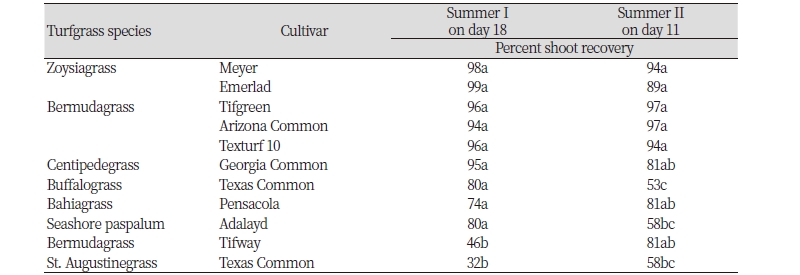Abstract
Comparative drought resistances of 11 perennial warm-season turfgrasses were evaluated in the field after withholding irrigation for 48 days in summer I and 57 days in summer II. There were significant variations among the grasses in their drought resistances. From two years study of field shoot recovery from drought stress, the relative rankings among the 11 warm-season turfgrasses was as follows. ‘Arizona Common’ and ‘Texturf 10’ bermudagrasses [Cynodon dactylon (L.) Pers.], ‘Tifgreen’ hybrid bermudagrass [C. dactylon (L.) Pers. x C. transvaalensis Davy], and ‘Georgia Common’ centipedegrass [Eremochloa ophiuroides (Munro.) Mack.] possessed good drought resistances, whereas ‘Texas Common’ St. Augustinegrass [Stenotaphrum secundatum (Walt.) Kuntze] and ‘Tifway’ hybrid bermudagrass [Cyndon dactylon (L.) Pers. x C. transvaalensis Davy] possessed poor drought resistances. ‘Texas Common’ buffalograss [Buchloe dactyloides (Nutt.) Engelm.], ‘Pensacola’ bahiagrass (Paspalum notatum Flugge.), and ‘Adalayd’ seashore paspalum (Paspalum vaginatum Swartz), ‘Meyer’ zoysiagrass (Zoysia japonica Steud.), ‘Emerald’ zoysiagrass (Z. japonica Steud. x Z. tenuifolia Willd. ex Trin.) were found to rank intermediate. Visual leaf firing showed the highest correlation (r=-0.84) to shoot recovery from drought stress. Visual leaf rolling (r=-0.59) and canopy-air temperature differential (r=-0.64) also showed very significant correlations, whereas leaf water potential (r=0.54) showed relatively lower correlation.
Figures & Tables



